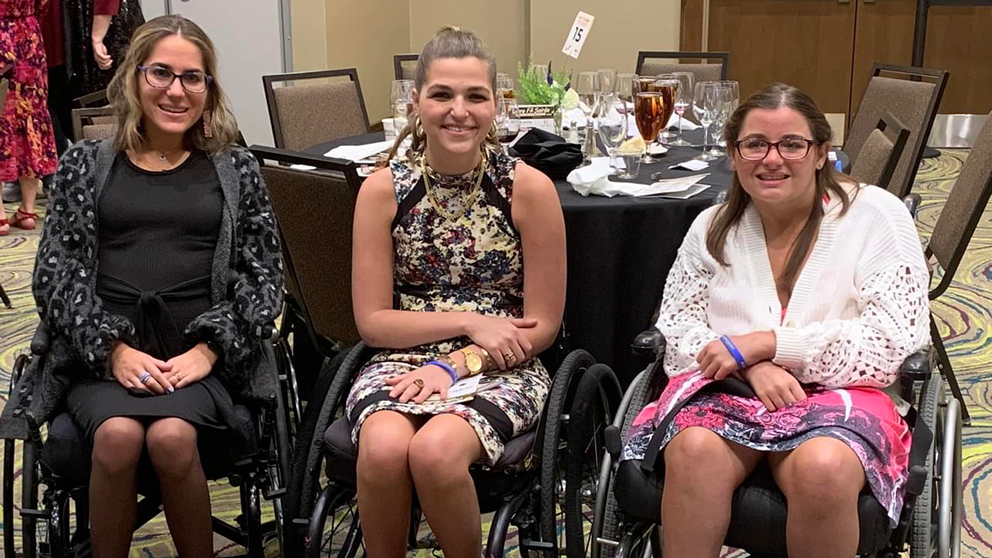 FA community members (l to r ) Noah, Christian, and Shandra with their service dogs (l to r) Schooner and Abbey. (Photo credit: Megan Wolf)
FA community members (l to r ) Noah, Christian, and Shandra with their service dogs (l to r) Schooner and Abbey. (Photo credit: Megan Wolf)
For the first time, there’s an FDA-approved treatment for Friedreich's ataxia (FA). Omaveloxolone (brand name Skyclarys) received approval in late February, and in June it became available in capsule form to patients aged 16 and over.
Skyclarys promotes improved mitochondrial function and boosts antioxidant activity, but it doesn’t directly address the underlying causes of FA: FXN gene mutations and low levels of the protein frataxin that FXN codes for, resulting in mitochondrial dysfunction and nerve and muscle cell degeneration. Skyclarys is nonetheless a major step forward for the FA community, but is something even better on the horizon?
What is Friedreich's ataxia?
Friedreich's ataxia (FA) is a rare recessive neurodegenerative disease, occurring in about one in 50,000 people. It’s caused by inheriting a defective copy of the FXN gene from both parents—people with one normal and one defective copy show no physical sign that they are potential carriers of the disease. Symptoms usually manifest in childhood, although in some people they appear around age 25 or even later, and may include impaired muscle coordination and difficulty walking, slurred speech, impaired sensory function, including loss of sensation, hearing and vision, and more. The rate of progression varies, but most people with FA are eventually confined to a wheelchair, and their life expectancy is shortened.
The gene defect that causes FA is called a triplet repeat expansion, in which hundreds of copies of a three-base DNA sequence (in FA it’s guanine-adenine-adenine, or GAA) are added to the usual gene sequence. Not surprisingly, the triplet repeats disrupt protein production, leading to low levels of frataxin activity and impaired mitochondrial function. As is frequently the case, cells in the nervous system are particularly sensitive to metabolic stress, leading to degeneration and the symptoms of FA.
Researchers at The Jackson Laboratory (JAX) have long investigated the biology of FA and potential therapeutic targets. Led by Cathleen Lutz, Ph.D., now VP, JAX Rare Disease Translational Center (RDTC), JAX has partnered with the Friedreich’s Ataxia Research Alliance (FARA) for more than 15 years. The initial focus was to serve as a repository and distributor for mouse models of the disease, including those engineered with human FXN genes containing triplet repeat expansions that showed FA-like symptoms and progression. Now a new research initiative is underway to implement the latest genomic editing techniques to address the actual genetic defect, with the goal of translating it to the clinic.
A therapeutic workaround
The road to approval for Skyclarys showcased the challenges of bringing rare disease therapies to the market. It was rejected by the FDA in 2020 for lack of data, but, by definition, increasing cohort sizes is exceedingly difficult for all rare diseases. The company that developed Skyclarys, Reata Pharmaceuticals, therefore extended the existing clinical trial, and it eventually demonstrated clear improvements in neurological functions with Skyclarys versus a placebo. Its recent approval represents a milestone for not only potential FA therapies but for all those developed for people with any of the thousands of known rare diseases.
That said, Skyclarys is, in effect, a therapeutic workaround. In fact, it’s not known exactly how it impedes or slows neurodegeneration, though it does activate the nuclear factor (erythroid-derived 2)-like 2 (Nrf2) pathway, alleviating the oxidative stress that is thought to interfere with proper mitochondrial function in FA. But it has no direct effects on FXN or frataxin production. Those who took it during the clinical trial also reported numerous side effects, including elevated liver enzymes, headache, and gastro-intestinal distress.
The approval of Skyclarys is a significant milestone for the FA community,” says Jennifer Farmer, FARA’s CEO. “It is the first treatment for individuals with FA that begins to address the unmet need, and it creates a development path for future therapies. We believe that FA will require multiple treatments or a cocktail of therapies to fully cure the disease.”
 Representing an engaged FA community, (l to r) Carly, Madelyn, and Emily gather at the Cure FA Soirée- an evening of music to benefit FARA. (Photo credit Tracy Weidman)
Representing an engaged FA community, (l to r) Carly, Madelyn, and Emily gather at the Cure FA Soirée- an evening of music to benefit FARA. (Photo credit Tracy Weidman)
Addressing the root cause
One potential alternative therapeutic strategy for FA and other rare genetic diseases is to go right to the source of the problem and edit the defective gene itself. The advent of CRISPR genome editing methods has made this strategy theoretically viable, but challenges with delivery—how do you safely get the CRISPR guide RNA and cas9 enzyme into enough cells?—and concerns about off-target DNA strand breaks have slowed development and clinical implementation. Now, the advent of a CRISPR-based gene editing method that allows for accurate gene repair without cleaving the DNA is providing a highly promising path forward.
Indeed, in June a major grant from the National Institute of Neurological Disorders and Stroke (NINDS) was announced that will fund Lutz and several research and clinical collaborators in their efforts to implement the new method, called prime editing, in preclinical models and, in the near future, provide the data needed to bring it to the clinic. The grant focuses on FA and three other rare neurodegenerative diseases—Rett syndrome, Huntington’s disease and spinal muscular atrophy—and carries with it the specific goal of advancing at least one candidate therapy through a successful investigational new drug (IND) application.
“The approval of Skyclarys was a real step forward for the FA and other rare disease communities,” says Lutz, “and we’re hoping that we can build on the momentum in the Rare Disease Translational Center. Our goal is to use the NINDS funding to bring a highly promising new therapy strategy to the clinic to benefit individuals and families dealing with these diseases.”
Rare is not rare
While each rare genetic disease affects relatively few individuals—at one in 50,000, FA is actually the most common form of ataxia—collectively nearly one in 10 people has some form of one. While some have treatments that can alleviate symptoms, most have no therapies available at all, and many of the diseases are irreversible and fatal. Therefore the FDA approval for Skyclarys resonates across rare disease communities well beyond FA and provides a little more hope for those who desperately need clinical progress, not just research discoveries.
“The work related to the prime editing grant is just one part of our efforts, and in the long run we are looking to do much more,” says Lutz. “We will provide the preclinical evidence so badly needed to lower the obstacles to drug development and benefit the individuals and families faced with a wide range of rare genetic diseases.”